Back when Ireland still had lighthouse keepers, the town of Dingle had a watchful one. Paddy Ferriter was a man who preferred the company of his dogs to that of most people. Through the autumn and winter of 1983, Ferriter had spotted a fellow loner in the water: a dolphin, following the fishing boats. Swimmers say they began cavorting with the dolphin in 1984.
Today, Fungie the dolphin still favors Dingle Harbor, a nick in Ireland’s westernmost peninsula. In a typical summer—one not ravaged by a global pandemic, as the summer of 2020 will be—thousands of tourists take boat trips to see him leap alongside their vessels. When the tourist traffic dwindles in winter, a small group of swimmers regularly heads out into the icy water to play with him. Floating just ahead of me on a gloomy day in October is one of them, Abi Dillon, keeping a sharp eye out for the dolphin.
I roll onto my back and spin around slowly to take in the town, the sea, the green buoy where the dolphin tends to linger. The old lighthouse stands atop the cliffs above. Beyond the harbor, the ocean surges and heaves, turquoise where it crashes on the rocks, gray beyond. Sea foam blows high onto the cliffs, where the prevailing winds have flattened the unearthly green grass. But inside the harbor, the rage dissipates. I rock on the gentle waves while Dillon slaps her bodyboard on the water, trying to attract Fungie’s attention.
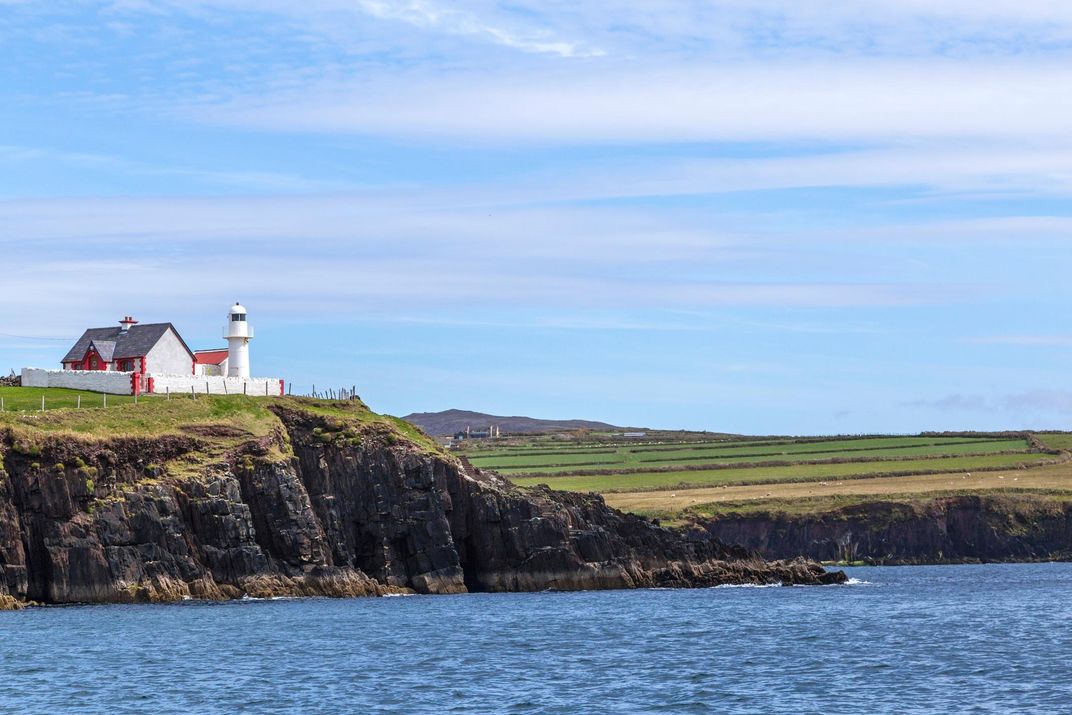
Fungie is not the only dolphin to break away from his kind and interact frequently with humans. Solitary-sociable cetaceans—including dolphins, belugas, and killer whales—have been reported all over the world. But Fungie is an outlier: after a world record–breaking 36 years in the company of humans, he’s still alive. Many solitary sociables meet early, grisly ends at the hands of our species.
Sometimes, people harm these animals on purpose. Sometimes, harm is the unintended consequence of an overwhelming human desire to be close to something mysterious. A wild creature’s attention can create a sense of connection that is difficult for some people to resist, even when it endangers the animal. As a veteran of human contact, Fungie may offer lessons about how we can do a better job of protecting the solitary cetaceans we love so fiercely, and so badly.
***
A bronze statue of Fungie, tail held jauntily in the air and grinning mouth agape, stands prominently on Dingle’s harbor front. The wind hums through the rigging of the yachts in the marina, mingling with tinny uillean pipe music blasting from a speaker near a gift shop stocked with dolphin T-shirts, jewelry, and toys. Signs advertising Fungie boat tours offer guaranteed sightings or your money back.
The guarantee is safe because, in some ways, Fungie is predictable. If boats are out in the harbor, he usually joins them. Like many other dolphins, he seems to enjoy riding their bow waves. But despite his routine, he’s an enigma even to the people who know him best.
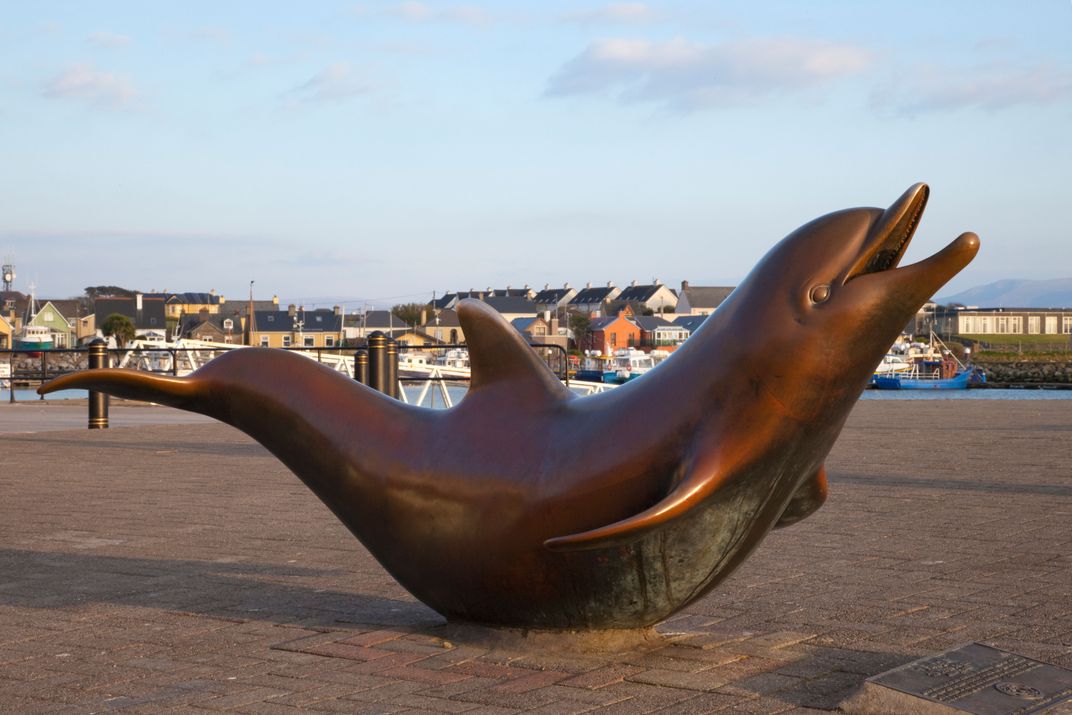
It’s unclear why a highly sociable animal like a dolphin would live alone. While it may be normal for dolphins to do so while shifting from one socially bonded group—called a pod—or partner to the next, an extended period of solitude is unusual. Researchers believe solitaries may be young dolphins whose pod was killed, or that left their birth pod but found no new group to join. Perhaps they are disabled or are dolphin outcasts. Or maybe, like Ferriter, the lighthouse keeper, they are loners that don’t care much for the company of their own kind.
Each case has unique factors, says dolphin conservationist Mike Bossley, research fellow emeritus at Whale and Dolphin Conservation. Bossley has worked with solitary dolphins since the mid-1980s. While we speak over a video call, the soft-spoken Australian cracks open his evening beer and apologizes for his dog slurping water in the background. In his experience, he says, solitaries’ unusual state is “first and foremost an affiliation with place.” Like Fungie, many attach to a small territory. Bossley spent a few years working with a solitary dolphin he named Jock, who didn’t leave his home range in a warm, polluted inlet, even though other dolphins seemed to avoid it.
Jock didn’t have a problem with other dolphins; he socialized with them when they were around. Fungie, too, has often shown up with tooth-rake marks from other dolphins—a sign of friendly interaction—but when they leave, he stays put. Whether this is a preference for the rich pickings of the harbor, a fear of what lies beyond, or something else is impossible to say. And there are solitary-sociable cetaceans that flout the territorial trend, showing up in different places hundreds of kilometers apart.
There are other loose commonalities between solitaries. After establishing a restricted home range, many begin to regularly follow boats and ride their bow waves. This brings them to the attention of people who know the water well, like Ferriter, or the fisherman whose nickname of Fungus—a teasing reference to his patchy beard—transferred to the dolphin.
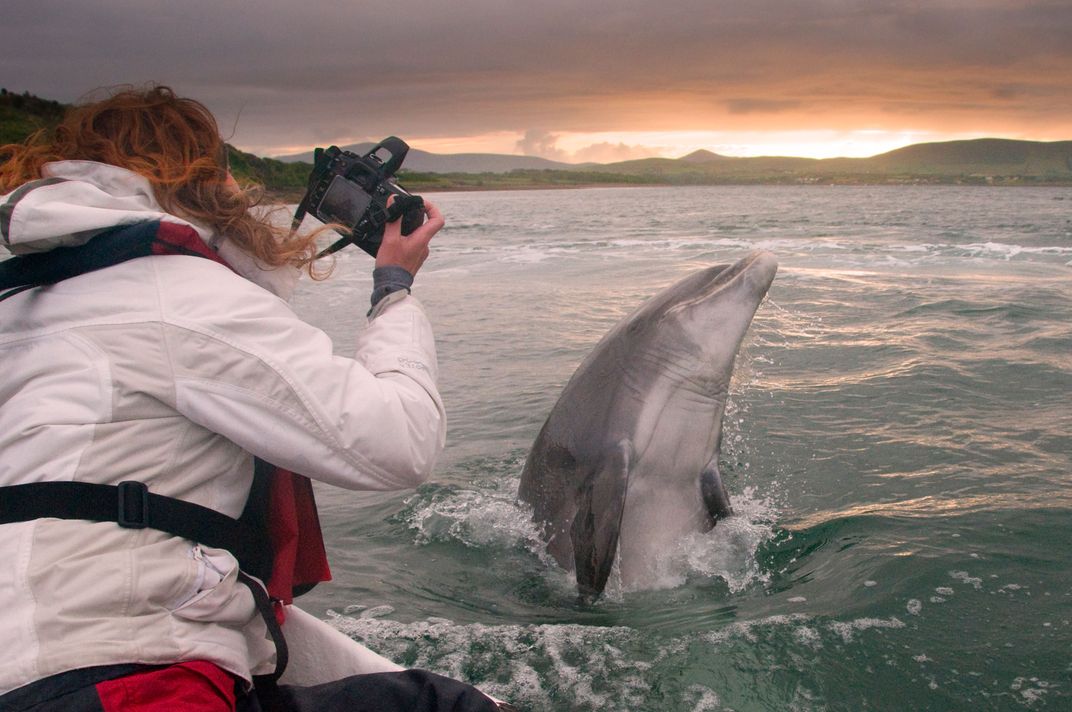
Over time, solitaries may get curious about people in the water—or perhaps it’s people who get curious about the solitary and get in the water more often. Initially, the cetacean will observe people from a distance, but if those people repeatedly try to make friends, the wild animal’s caution may fall away. The divers who began swimming with Fungie soon after his arrival, for example, may have increased his trust in people. For a while, he allowed certain people to touch him, and one swimmer reports that Fungie took children for rides on his back. This may just be part of Dingle’s copious dolphin mythology, but it’s not impossible: other solitaries have given “fin tows” and permitted or even sought touch from humans.
But as Fungie stayed, he seemed warier of the newcomers that replaced the original swimmers. Graham Timmins, who swam with Fungie in the early 1990s, says that the dolphin avoided close physical contact with most swimmers by the time he arrived. Even so, Fungie still seemed to enjoy bouts of raucous play with bodyboarders, who would kick tight circles through the water while the dolphin leaped overhead. He toyed with kayakers’ paddles or rubbed his flanks against them for a scratch. The small community of regular swimmers tried every kind of toy and noise-making device they could think of to keep the dolphin entertained. They rattled chains, played trumpets, and towed empty barrels behind boats.
Holding Fungie’s attention proved more difficult as time wore on, though. By 1994, “the dolphin was ignoring me totally,” writes Timmins on his website tracking Irish solitaries. Swimmers fell in and out of favor, and Fungie seemed to prefer the excitement of leaping in bow waves, eschewing humans for the burgeoning fleet of tourist boats. These days, swimmers wait until the tourist season is over, braving the icy harbor in winter. Even then, they may get nothing more than a fleeting dance. But just 30 seconds with him is exhilarating, says Suzanne Massett, who has been swimming with Fungie for more than 20 years. She first swam with him on vacation from Dublin, but the dolphin—and Dingle itself—drew her back permanently.
Dillon has also steered by Fungie’s star. She first saw the dolphin in 1998 from a tourist boat, as a teenager on vacation from England with her family. The following year, she joined a group swimming trip operated by a tour company. “The visibility was never great,” she says. “And he wasn’t really close to us.” But as her mother fell in love with the Dingle peninsula and her family began to visit regularly, Dillon fell in love with the dolphin. Her face lights up when she describes her first encounter with Fungie underwater: “The way the light was dappling, and the water was reflecting … it was really magical.”
When we meet at a bright, noisy coffee shop on the main street, Dillon brings reams of diary entries, photographs, and notebooks tracking her early encounters with Fungie and other solitaries. They depict a shy teenager finding joy and increasing confidence in the thing that made her special—her relationship with the dolphin—and daydreaming of the day she would be able to move to Dingle permanently.
That sense of being chosen, of holding a wild animal’s attention, seems to be what draws people to solitaries, says Bossley. It’s a feeling that can lead down a dangerous path: “People love to construe that the dolphin—Jock, or whoever—has special feelings for them. That’s pretty dubious, in my opinion.” There is no question that dolphins are intelligent, social creatures. But anthropomorphizing them—imagining that they think or feel the same way humans do—can lead people to interpret their needs, behaviors, and social cues incorrectly, often with serious consequences.
In Dingle, though, anthropomorphizing Fungie may have worked in his favor. Once the dolphin appeared to set boundaries, the local swimming subculture fell in line with what he seemed to want. Recent generations of swimmers have never known it any other way. “We always had an unsaid rule that we would never try to touch,” says Massett. “We just didn’t feel that that was our place.” Fungie’s boundaries, and swimmers who respect them, may have helped protect the dolphin from the disastrous fates of other solitaries, whose interactions with people often become more extreme over time.
***
Solitary sociables have elicited awe, affection, and resentment for centuries. Nearly 2,000 years ago, Roman naturalist Pliny the Elder wrote of a dolphin in present-day Tunisia that played with swimmers, carrying them on his back and enjoying their caresses. In the 1890s, a Risso’s dolphin that took up residence in Pelorus Sound in New Zealand and frequently approached boats gained such popularity that people eventually demanded legal protection for him. Tião, a bottlenose dolphin, spent a few months in 1994 interacting with swimmers on a stretch of coast near São Paulo, Brazil. Luna, a young killer whale, lived for years in the early 2000s in Nootka Sound, British Columbia. A small but steady trickle of solitary beluga whales shows up on the east coast of Canada and the northeastern United States, far from their home turf.
Bottlenose dolphins are by far the most common species to become solitary, especially in Britain and Ireland, where some have become established enough to attract crowds. Dave the dolphin, actually a female, took up residence off the southeast coast of England in 2007. Up to 40 people would join her in the water at peak times, while as many as 700 people watched from the shore.
Swimming with dolphins sounds idyllic to people, but it can be hellish for dolphins. Dolphins like Dave find themselves crowded in shallow water with no escape route, while people grab them or touch sensitive blowholes, eyes, or genitals. People might behave badly simply because they don’t understand enough about wild dolphins. But sometimes, the reason for mistreatment is more malign. In 2007, two men were arrested and convicted for drunkenly harassing Dave. Some of the people who interacted with Tião grabbed his fins, hit him, and tried to put ice cream sticks in his blowhole. Unsurprisingly, Tião defended himself by ramming them with his “beak,” or rostrum. During his five-month residence near São Paulo, he injured 29 swimmers. Other dolphins have also injured humans when they felt threatened or crowded.
Tião eventually killed one man, who died from internal bleeding. But such cases are rare. Humans, on the other hand, often kill solitaries. Tião disappeared, and researchers speculate that someone killed him in retaliation for the death. Dave also went missing shortly after losing a large chunk of her tail to a boat propeller. In Pliny’s account, townspeople killed the Tunisian dolphin out of frustration with the influx of tourists. A tugboat struck and killed Luna.
According to researcher Toni Frohoff, dolphins that are in frequent contact with humans are at higher risk of injury, illness, or death at human hands than dolphins that aren’t. Their habitual proximity to us makes them more vulnerable to threats like boat strikes, fishing line entanglements, underwater explosions, and pollution. Even well-behaved human swimmers can harm an animal’s well-being. Dave, for example, fed and rested less during periods of intensive human interaction, scientists found. And any habituation leaves the animals more vulnerable to harassment and stress from less responsible people.
It’s becoming more urgent to mitigate these risks, as reports of solitary cetaceans have increased in recent years. With growing coastal human populations, more water-based recreation, and access to social media increasing, there may simply be more people around to see and report solitaries. It’s also possible that there are more of them to be found. Increasing deaths of cetaceans near coasts could mean more animals—lone survivors from their groups, or young dolphins setting out from their families but failing to find a new pod—turning up alone. And people may create long-term solitaries from temporary loners by habituating them to our company. Swimming with dolphins is such a common bucket list item that the sight of a dolphin fin inspires many people to “rip off their clothes and leap into the water,” jokes dolphin researcher Bossley.
As interactions between humans and cetaceans increase, there may be more grisly endings on the horizon—unless people learn to manage the situations better.
***
The driving rain stings my face as Dillon and I head down to the beach, my jacket soaking through in minutes. I generally enjoy the high of cold-water swimming, but even for me, the frigid gray harbor looks anything but inviting. Dillon points out Fungie arching gracefully out of the water across the harbor. We are far less graceful, penguin-walking in our wetsuits and fins to the water’s edge. Icy water trickles down my back as I submerge. To warm up, I halfheartedly swim laps parallel to shore, but the ill-fitting rented wetsuit restricts my movement, so I give up and follow Dillon farther out.
As the water deepens and darkens beneath me, I start to feel guilty about seeking contact with a wild dolphin, given what I know about the harm it can do. Still, the chances of seeing Fungie up close are slim. And Fungie’s admirers point out that he initiates all the contact he has with people. Sometimes he’s nowhere to be found, which suggests that he’s capable of keeping interactions on his terms. The time to avoid him may have been decades ago, when he first arrived in Dingle Harbor. “What would have happened if no one had got in the water with him?” Dillon asks. “Would he have stayed around?”
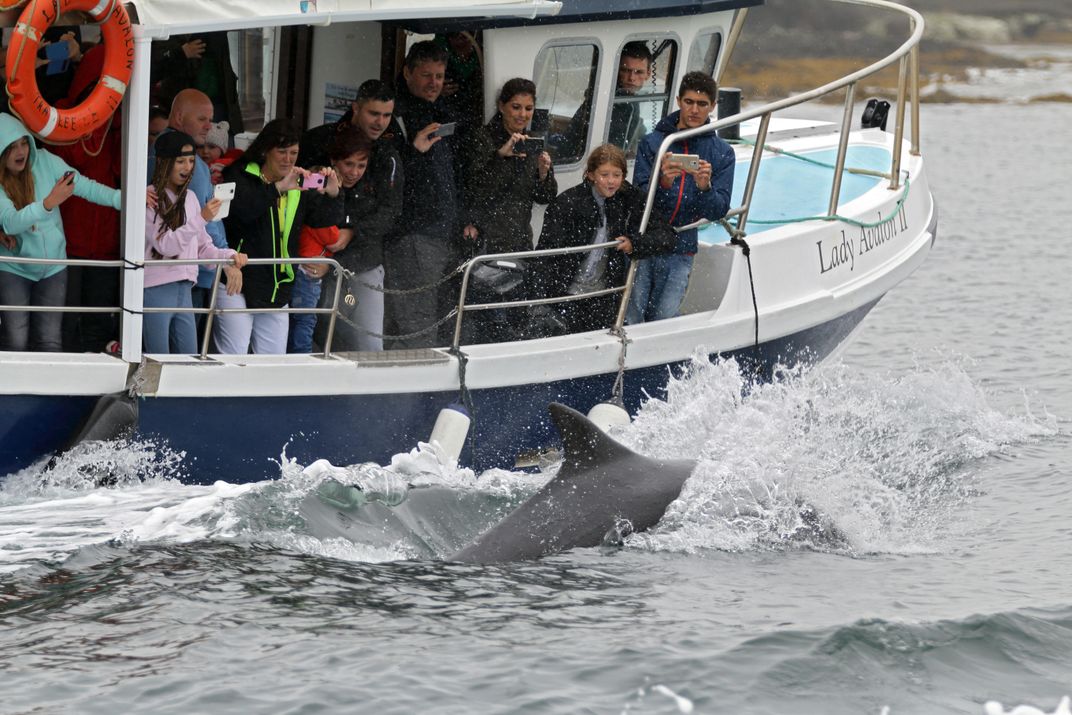
The safest possible approach to a new solitary is to head off habituation before it happens—and perhaps even try to reintegrate the solitary animal with its own species. That’s a rare feat, but it’s worked before. Bossley and his collaborators used solitary Jock’s penchant for leaping in the wake of a boat to slowly lead him farther from his home range. Eventually, he spent more time with other dolphins.
Once an animal is used to humans and starts seeking their company, cutting off interaction may not always be the answer. Luna, the killer whale who lingered in Nootka Sound, relentlessly approached boats for games and attention, even as Fisheries and Oceans Canada tried to keep the whale and people apart. When a solitary cetacean is perhaps gaining needed social fulfillment from human contact, blocking further interaction could be harmful, researchers wrote last year in a veterinary journal.
Instead, they recommend measures like limiting the number of people who can interact with the animal at the same time, as well as education efforts that teach people not to touch blowholes, not to offer food, and how to recognize agitation. Another Irish dolphin, named Dusty, injured a swimmer in 2013 who didn’t immediately understand that the dolphin’s tail slapping was a signal to back off. More information could have saved the swimmer from a devastating injury and protected Dusty from unnecessary stress.
Ultimately, each solitary cetacean needs a unique approach that takes into account the extent of its habituation, its personality, local legislation, and other factors. But that’s tricky, because conservation authorities and scientists tend to focus on populations. Lone animals can fall through the cracks, leaving their protection in the hands of nonprofits and community members.
In some places, official guardians watch over a resident cetacean. The mayor of Collioure in France, for example, appointed a guardian with police backup to stop people from grabbing Dolphy the dolphin’s dorsal fin. On Providenciales, an island in the Caribbean, a permanent guardian watched over JoJo the dolphin, entertaining him and protecting him from people. But individual guardians can sometimes cause problems if they become possessive and emotionally dependent on the animal, says Bossley.
At Monkey Mia Reserve in Australia, where a group of dolphins regularly accepts food from people, park rangers supervise huge crowds. Because of their authority and law-enforcement power, rangers are the ideal way to ensure animal and human safety, Bossley argues—but budgets don’t necessarily allow for full-time rangers to monitor a single animal.
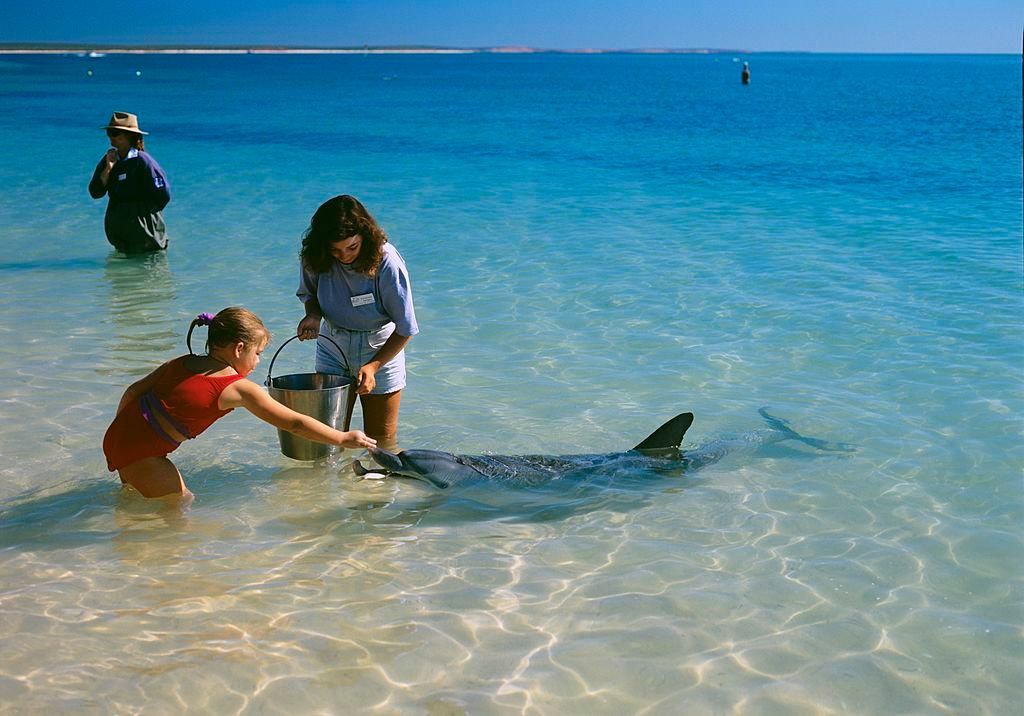
Fungie’s longevity seems to rise not from an explicit management plan, which Dingle has never had, but from a lucky convergence of factors. The dolphin’s own aloofness may have kept him safe from the kind of harassment suffered by Dave and Dusty. The Dingle community, proud of their mascot and enjoying a thriving dolphin tourist industry, protects him. Nigel Collins, the Dingle harbormaster, says that tourist boat operators pulled back over the summer of 2017, when Fungie didn’t seem well and wasn’t interacting normally. “His welfare is their welfare,” he says. “They’re quite vocal about people harassing him in recreational boats.”
Meanwhile, the community of swimmers has long opted for information sharing over possessiveness, passing on their hands-off swimming culture to successive generations of curious swimmers, like me. Dingle has achieved some of what researchers say a management plan should include: cooperation between boat owners, public education, and community involvement.
As I float in Dingle Harbor, I’m almost relieved that we’ve seen no more sign of Fungie. Then, suddenly, Dillon squeals and kicks her bodyboard into a spin. A dorsal fin and gleaming back arch out of the water as Fungie circles her neatly once, less than a meter away, and disappears.
We wait a while longer, watching him surface farther away. He doesn’t return. Elated with our small glimpse, we head back to shore. As we struggle to pull dry clothes onto our clammy skin in the light drizzle, we see Fungie pop up nearer the beach. It’s not uncommon, Dillon says, for him to seem to tease her like this, appearing just as she’s left the water. His visit this morning feels like a courtesy—a tip of the hat before vanishing again to finish his breakfast. But despite his carefully maintained distance, even Fungie faces risks as he ages.
***
Fungie appeared to be young, though sexually mature, when he arrived in Dingle, which would make him at least 45 years old today. Bottlenose dolphins in the wild live 17 years on average, although captive dolphins have lived as long as 50 years. As time passes, his reflexes may slow and his hearing may diminish, says Margaux Dodds, cofounder of Marine Connection, a nonprofit that campaigns to protect cetaceans globally, including solitary ones. Over the years, he’s had some close shaves—cuts that have worried his admirers, says Dillon, and on one occasion, a fish hook stuck in his eye.
Given his advanced age, Marine Connection is now working to support locals in ensuring that Fungie gets more breaks from the tourist boats, since he doesn’t seem interested in taking them himself. At the height of summer, as many as four or five cluster in the water, and Fungie is in the habit of following all of them, most of the time—meaning he may not be resting or feeding enough. After public complaint, the Irish National Parks and Wildlife Service reminded Dingle boat operators that, in Irish waters, dolphins are legally protected from disturbance, including from tourism. But no one has been issued a fine or formal warning, and prevailing sentiment in Dingle is that Fungie looks out for himself pretty well.
Whatever happens, it’s clear that Dingle won’t have its dolphin for much longer. Some boat companies have already branched into ecotours. Massett hopes that Fungie just quietly vanishes one day: “I would hate to think that he would wash up somewhere.” Vastly preferable, she says, would be if “he just disappeared as he appeared.”
As solitaries continue to find their way into the hearts of coastal communities, there is a chance to put our tendency to anthropomorphize them to good use. Human impact on the oceans can be difficult to comprehend in the abstract, but solitary cetaceans can make the stakes sharply visible, and give them a name, a face, and a personality. Solitaries may be more likely to suffer brutal deaths, but all dolphins share their vulnerabilities, Bossley says. If you connect with the story of a solitary dolphin, he suggests, it’s easier to care about protecting dolphins: “We’re storytelling animals.”
Still, interactive dolphins like Fungie could give people unrealistic expectations for wild dolphins, says Simon Berrow, CEO of the Irish Whale and Dolphin Group: “You’re going away thinking that’s what dolphins do.” There are healthier options for conservation mascots, he points out. Researchers often track pods for generations and know individuals well, offering ample opportunities for storytelling if those details are communicated to the public. And it’s not clear that people who see a dolphin like Fungie do actually leave the experience with more concern for dolphin conservation, Berrow adds.
On my final morning in Dingle, I set out for one last swim with Dillon and Massett. A freak surge of jellyfish litters the shore and I try not to think about the wetsuit tear over my ankle. The October morning is bright and crisp and the water so icy that when I duck beneath, I come up gasping. I float on my back, spinning again to take in the view, while Massett and Dillon rest on their bodyboards and chat. Every so often, they slap the water to let Fungie know they’re around. But he’s fishing out toward the open water and shows no interest in saying hello. He’s a wild dolphin. He doesn’t come when he’s called.
This article is from Hakai Magazine, an online publication about science and society in coastal ecosystems. Read more stories like this at hakaimagazine.com.
Related stories from Hakai Magazine:
Planning Your Next Trip?
Explore great travel deals
Smithsonian magazine participates in affiliate link advertising programs. If you purchase an item through these links, we receive a commission.
/https://tf-cmsv2-smithsonianmag-media.s3.amazonaws.com/filer/a7/12/a7129cf2-1487-4ad7-a9b4-d6f36d2e3e76/fungie_the_dolphin-mobile.jpg)
/https://tf-cmsv2-smithsonianmag-media.s3.amazonaws.com/filer/f6/e9/f6e9aeeb-17ff-4ded-97a6-201faadaa882/fungie_the_dolphin-social.jpg)